Castle Pics
-
Ok heres a thread for pics of castles ONLY. I'll accept palaces and forts(and remains) in the defination of a castle.
-
I'll start off a small presnetation of 6 castles I visited on my road trip last week.
1st up:
Highclere Castle
Highclere Castle is a Victorian country house in high Elizabethan style, with park designed by Capability Brown, in a 24 square kilometre estate south of Newbury, Berkshire, England. It is the country seat of the Herbert family, the Earls of Carnarvon, and the largest mansion in Hampshire.
The current Lord Carnarvon(8th Earl of Carnarvon) is the grandson of the famous Lord Carnarvon(6th Earl of Carnarvon) who, with Howard Carter, discovered King Tut's tomb. The 6th Earl of Carnarvon famously died of a mosquito bite, which many attributed to the curse of King Tut's tomb.
Sidenote: the 3rd castle I'll show has some links to "Capability Brown" as well. -
Roman Caerleon
Caerleon is a site of considerable archaeological importance, being the site of a Roman legionary fortress (it was the headquarters for Legio II Augusta from about 75 to 300 AD) and an iron age hill fort.
The name Caerleon is commonly thought to be from the Welsh for "fortress of the legion"; the Romans themselves called it Isca Silurum, "Usk of the Silures", after the Silures, the Celtic tribe that dwelt there.
Substantial excavated Roman remains can be seen, including the military amphitheatre, one of the most impressive in Britain, barracks and defensive formations, and the bath house, with a modern museum in situ above it. Both sites are administered by Cadw. There is a separate museum, part of the National Museums and Galleries of Wales complex, which exhibits finds from excavations throughout the village.
Because of its circular form, the unexcavated amphitheatre was known to locals as "King Arthur's Round Table". An initial investigation in 1909 showed the potential for a full-scale excavation of the structure, which began in 1926 and was supervised by Victor Nash-Williams. This revealed, among other things, that the amphitheatre had been built around 90AD, but had twice been partially reconstructed, once in the early part of the 2nd century AD, and again about a hundred years later. The arena is oval in shape, with eight entrances, and the stadium is thought to have had a capacity of around 6000.
Caerleon and Arthurian Legend
Caerleon is one of the sites most often connected with King Arthur's Camelot. There was no Camelot mentioned in the early Arthurian traditions recorded by Geoffrey of Monmouth, Wace, and Layamon. These early Arthurian authors say that Arthur's capital was in Caerleon, and even the later recaster of Arthurian material, Sir Thomas Malory, has Arthur re-crowned at "Carlion" (Caerleon). It has been suggested that the still-visible Roman amphitheatre at Caerleon is the source of the 'Round-Table' element of the tales, and was used for discussion and entertainment. (The "Camelot" reference originates with the French writer of courtly romance, Chrétien de Troyes.)
Geoffrey of Monmouth writes of Caerleon in the mid 12th century:
"For it was located in a delightful spot in Glamorgan, on the River Usk, not far from the Severn Sea. Abounding in wealth more than other cities, it was suited for such a ceremony. For the noble river I have named flows along it on one side, upon which the kings and princes who would be coming from overseas could be carried by ship. But on the other side, protected by meadow and woods, it was remarkable for royal palaces, so that it imitated Rome in the golden roofs of its buildings... Famous for so many pleasant features, Caerleon was made ready for the announced feast." (Historia Regum Britanniae "History of the Kings of Britain")
Caerleon also has later Arthurian literary associations, as the birthplace of the writer Arthur Machen who often used it as a location in his work. Alfred Lord Tennyson also wrote his Idylls of the King overlooking the Usk in a bay window of what is now the saloon bar of the Hanbury Arms public house.
In Michael Morurgo's novel Arthur, High King if Britain, Caerleon is the castle where Arthur unknowingly commits incest with his half-sister Margause, resulting in the conception of his bastard son Mordred, who will later bring about his downfall.
The Barracks
A paranomic view of the barracks:
A close up of the defensive formations, showing the ramparts with the trench on the other side, and gaps where entrances to the fortified barracks would have been:
The fort from the "outside", showing the defensive trench in front of the defensive ramparts.
The Amphitheatre
A paranomic view of the amphitheatre: -
Caerleon Norman Castle
The Domesday Book tells us that there was a castle in Caerleon soon after the Norman conquest:
"William de Scohies holds 8 carucates of land in the jurisdiction of Carlion castle, Â…"
The original castle was in all probability a timber tower on top of a mound surrounded by a ditch. During later years the timber structure was replaced by a solid stone tower and extensive walls were added.
The mound is still visible even behind the high Mynde walls, but, unlike the Roman ruins in Caerleon, very little of the medieval stonework remains.
Picture of the mound from "outside" the castle walls:
From historical sources, it can be deduced:
The castle was large and impressive.
It may well have included the old Roman walls as an outer defence.
A high stone tower stood on top of the mound.
The mound was surrounded by a moat until 1839 (Woollett). It was probably approached over a drawbridge. Two towers guarded its base. A flight of steps led to the tower. The mound was built on top of an earlier structure, which may well have been pre-Roman.
There was a bailey, and probably an outer bailey on the river side. (Judging by the line of the remaining wall and difference in ground levels either side of it.)
The gatehouse identified by Coxe was probably the main entrance to the castle, a short distance from the bridge.
There were round towers at points around the caste walls.
Additional towers (probably outside the castle walls) guarded the river.
It is likely that much of the stone used for building the castle was taken from the abundant Roman remains. Later, the castle ruins were used, in their turn, as a quarry for building stone.
Written account of William Coxe, 1801
In 1801 William Coxe published "An Historical Tour in Monmouthshire". His observations in Caerleon were based on visits over several years. During just this short time he saw parts of the castle remains being dismantled for building-stone. -
Considered by many one of the most beautiful castles in all Europe, Peles Castle is a masterpiece of German new-Renaissance architecture. Commissioned by King Carol I in 1873 and completed in 1883, Peles' interiors are an opulent display of elegant design and historical artifact. Its 160 rooms are adorned with the finest examples of European art, Murano crystal chandeliers, German stained-glass windows, walls covered with Cordoba leather, Meissen and Sevres porcelains, ebony and ivory sculptures.
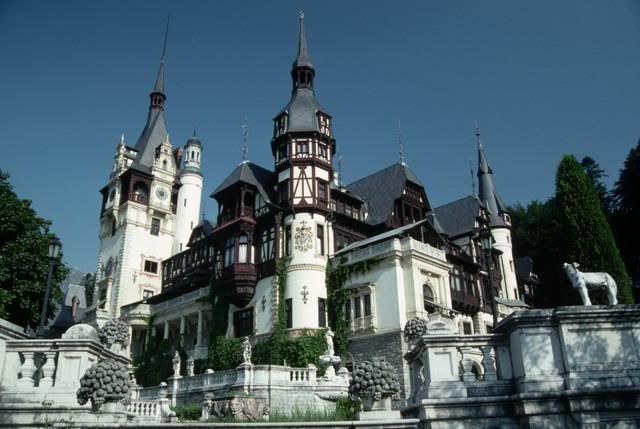
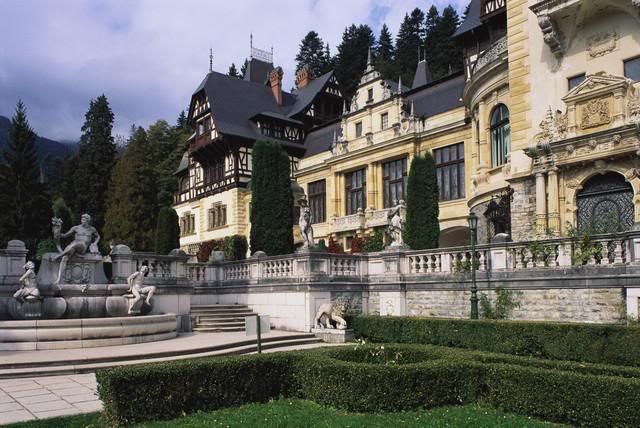
-
lol.
NICE!
-
This fortified medieval castle, often referred to as Dracula's Castle, was built in 1377 to protect nearby Brasov from invaders. It also served as a customs station.
The castle's rooms and towers surround an inner courtyard. Some rooms are connected through underground passages to the inner court. In 1920, the people of Brasov who owned the castle offered it as a gift to Queen Maria of Romania, and the castle soon became her favorite residence.
Bran is home to a rich collection of Romanian and foreign furniture and art items from the 14th-19th Centuries. The castle sits high atop a 200 ft. tall rock overlooking the picturesque village of Bran.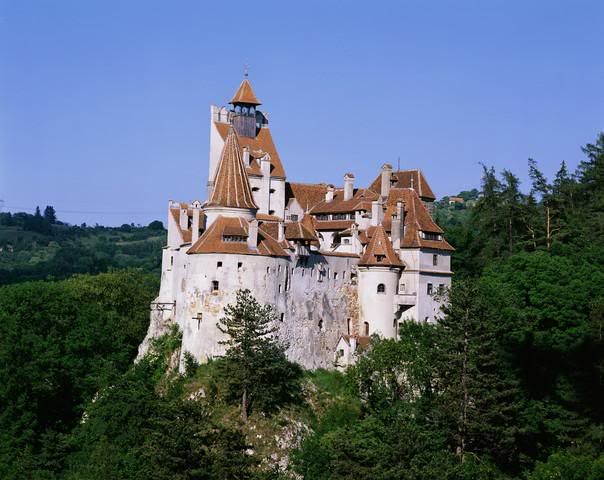
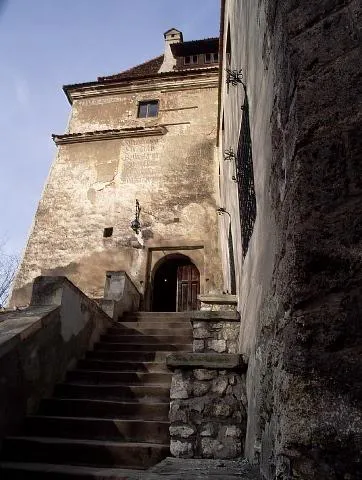
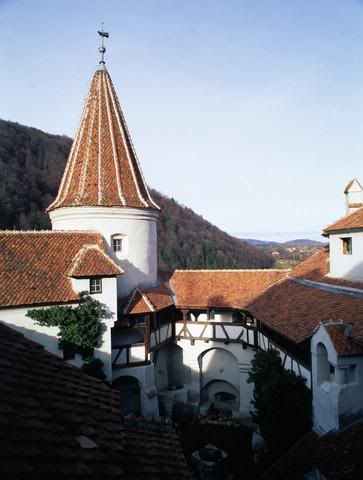
And Dracula's Bed....

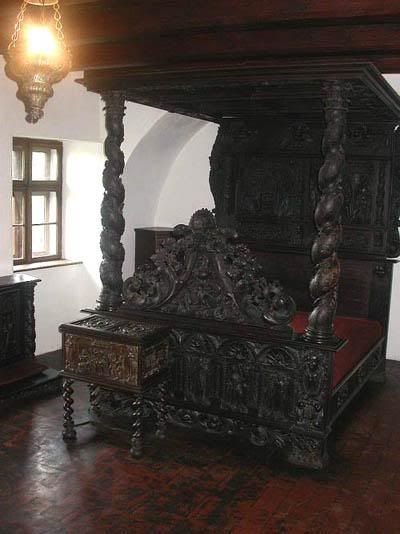
-
that is one sweet castle.Originally posted by mhcampboy:Considered by many one of the most beautiful castles in all Europe, Peles Castle is a masterpiece of German new-Renaissance architecture. Commissioned by King Carol I in 1873 and completed in 1883, Peles' interiors are an opulent display of elegant design and historical artifact. Its 160 rooms are adorned with the finest examples of European art, Murano crystal chandeliers, German stained-glass windows, walls covered with Cordoba leather, Meissen and Sevres porcelains, ebony and ivory sculptures.
-
I love Romanian castles.Gimmie some time I'm putting up Cardiff Castle.

-

nicer.
-
Matsumoto Castle
Matsumoto Castle is one of Japan's historic castles. Located in the city of Matsumoto, in Nagano Prefecture, it is within easy reach of Tokyo, making it popular with tourists from Japan and other countries.
This castle is also called Crow Castle because of its black walls and spreading wings. It is an example of a flatland castle, not being built on a hilltop or amid rivers.
The castle's origins go back to the Sengoku (Warring States) period. At that time, the Ogasawara clan built a fort on this site, which was originally called Fukashi Castle. Later, it came under the rule of the Takeda clan and then Tokugawa Ieyasu.
When Toyotomi Hideyoshi transferred Ieyasu to the Kanto region, he placed Ishikawa Norimasa in charge of Matsumoto. Norimasa and his son Yasunaga built the tower and other parts of the castle, including: the three towers, the tenshu (donjon tower), inui-kotenshu (small tower in the northwest), watari-yagura (connecting scaffold), goten (residence), taikomon (drum gate), kuromon (black gate), yagura (scaffold), hori (trench), honmaru (the main wing), ninomaru (the second wing), sannomaru (the third wing), and the sub-floors in the castle, much as they are today. They were also instrumental in laying out the castle town and its infrastructure. It is believed much of the castle was completed in 1593-4.
During the Edo period, the Tokugawa shogunate established the Matsumoto Han, of which the Matsudaira, Mizuno and others were the daimyo.
In 1872, following the Meiji Restoration, the tower was sold at auction and was at risk of being dismantled. However, with the cooperation of Ichikawa Ryozo and other people of Matsumoto, it was spared. The Kuromon-ninomon (second gate of the black gate) and sodebei (side wall) were reconstructed in 1990. The taikomon-masugata (square-shaped drum gate) was reconstructed in 1999.
The tower of Matsumoto Castle is listed as a National Treasure of Japan.

Hara Castle
In 1637, the people of Amakusa and Shimabara rose up together to demand Christian's liberty and equality. This monumental action is known today as the Amakusa-Shimabara Rebellion. Its leader was a young man of only 15, Amakusa Shiro. The attempted revolution ended four months later when the revolutionary forces were wiped out by 120,000 soldiers of the shogunate at the battle of Harajo Castle on the Shimabara Peninsula. However, at that time, the 37,000 Christians and farmers, with Amakusa Shiro as their driving forcer were united in an unwavering pursuit of their goal. The ruins of Harajo Castle are 45 minutes from Shimabara Gaiko station by Shimabara private railway to Harajo station, and then a 10 minute walk. The high ground of the inner citadel is now used as a park. Many Christian related items have been excavated from the site.
what was left..


a tower left to act as museum..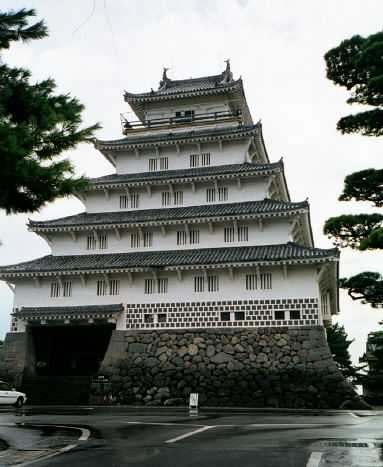
-
Casa Loma in Toronto, Ontario, Canada

Casa Loma is the unique legacy of Sir Henry Mill Pellatt, a prominent Canadian financier, industrialist and military officer of the early twentieth century. An unabashed romantic, Sir Henry engaged the noted architect E.J. Lennox to help him realize a life-long dream - the creation of a 'medieval' castle on the brow of a hill overlooking Toronto. Based on a life-long fascination with European castles, Sir Henry borrowed the most pleasing elements of Norman, Gothic and Romanesque styles to create Casa Loma.
......extracted from http://trimpe.org/casaloma/history.htm -
The Breakers

The Breakers is located on Ochre Point Avenue, Newport, Rhode Island, on the Atlantic Ocean.
The Breakers is a mansion, built as the Newport summer home of Cornelius Vanderbilt II, a member of the wealthy United States Vanderbilt family.
............taken from http://en.wikipedia.org/wiki/The_Breakers -
the singapore castle.
http://www.sgforums.com/?action=thread_display&thread_id=183581 -
Chateau Le Frontenac in Quebec, Canada

-
i have to get my ass to posting the rest of the castles. erf.
-
not sure if anyone posted this b4. but this has got to be one of my fav castles
Schloß Neuschwanstein
Neuschwanstein Castle (German: Schloß/Schloss Neuschwanstein, lit. New Swan Stone Castle; IPA pronunciation: /nɔy'ʃvanʃtain/) is a late 19th century castle in Germany, near Hohenschwangau and Füssen in southwest Bavaria, not far from the Austrian border at approximately 47°33′16″N, 10°44′10″E. It is the most photographed building in Germany [1], and is one of Germany's most popular tourist destinations.
Construction was started by King Ludwig II of Bavaria, also known as "Mad King Ludwig". It was named after the Swan Knight, Lohengrin, of Wagner's opera, and was designed by Christian Jank. The castle is located near Hohenschwangau Castle, an older structure restored by Ludwig's father, Maximilian II of Bavaria. Owing to his eccentricites and his perceived use of Bavarian funds (a myth, as Ludwig actually used his own money to finance the construction of the castle), Ludwig was removed from power before the castle was completed. Soon after Ludwig's mysterious death (he drowned in Lake Starnberg) in 1886, the castle and its amazing interior were opened to the public. Many tapestries and paintings depict scenes from the operas of Richard Wagner, a reflection of Ludwig's love for Wagner's work. However, many of the interior rooms remain undecorated; only 14 rooms were finished before Ludwig's death.
At the end of the second World War a hoard of gold from the German Reichsbank had been stored in the castle. In the last days of the war it was carried off to an unknown place. According to unproven rumours it was plunged into the nearby Alat lake. Many other items, such as gold snuff boxes, antique jewelry, furniture, and famous paintings (all stolen), were also stored at the castle. They were destined for Adolf Hitler's personal collection.
Neuschwanstein, the (relatively) modern fairy-tale castle of Bavaria, inspired the modern fairy-tale castle at Disneyland, Sleeping Beauty Castle. The inspiration for the Cinderella Castles at other Disney parks is sometimes incorrectly attributed to Neuschwanstein. The basis for those designs is the Château d'Ussé in France -
Originally posted by HENG@:
not sure if anyone posted this b4. but this has got to be one of my fav castles
[b]Schloß Neuschwanstein
Neuschwanstein Castle (German: Schloß/Schloss Neuschwanstein, lit. New Swan Stone Castle; IPA pronunciation: /nɔy'ʃvanʃtain/) is a late 19th century castle in Germany, near Hohenschwangau and Füssen in southwest Bavaria, not far from the Austrian border at approximately 47°33′16″N, 10°44′10″E. It is the most photographed building in Germany [1], and is one of Germany's most popular... ....
[/b]



(edited to put in a working hotlink for pic) -
Heng@, do you go on the walking tour inside these castles?
I've been inside the Casa Loma and Breakers. Fantastic. The material they used, the size of it for that matter. Awesome! And the Breakers actually back the Atlantic ocean.
I took the walking tour otherwise can get lost.
-
Château d'Ussé

The Château d'Ussé is located in the commune of Rigny-Ussé in the Indre-et-Loire departement, in France. An 11th century stronghold for the Comte de Blois, the first castle was built on a high terrace at the edge of the Chinon forest overlooking the Indre Valley.
History
The structure was almost completely rebuilt by Jean Bueil, a compatriot of Joan of Arc, during the middle part of the 15th century. His son, Antoine Bueil, married the daughter of King Charles VII of France and continued with his father's building efforts. In 1485 Charles d'Espinay bought the castle and continued the rebuilding, walled the courtyard and arranged for his son to build the collegiate church in 1520.
Built in the white tuffeau (tufa) stone of the Loire Valley, each of the exotic castle's wings is filled with turreted towers, capping crenellated and machicolated battlements.
The d'Espinay family sold the castle in 1557 and for the next 110 years, it was little used and allowed to decline. Restored by the Bernin family it was sold twice before the French Revolution after which it sat empty until 1808 when the Duc (Duke) de Duras purchased the estate. Wealthy, and in the employ of King Louis XVIII, the Comtesse Auguste (de Duras) had the castle fully restored. Descendants of the Duc de Duras remain the current owners of the Château d'Ussé
Author Charles Perrault used Château d'Ussé in his famous fairytale, Sleeping Beauty. Inside the castle, visitors today can see a waxwork tableau from the fairytale.
Further, the castle serves as the inspiration for the designs of Cinderella's Castle at Walt Disney World Resort's Magic Kingdom -
i do take walking tours because they are very informative and educational. But I enjoy exploring on my own as well.Originally posted by littlestream:Heng@, do you go on the walking tour inside these castles?
I've been inside the Casa Loma and Breakers. Fantastic. The material they used, the size of it for that matter. Awesome! And the Breakers actually back the Atlantic ocean.
I took the walking tour otherwise can get lost.
for 2 of the castles i visited on my trip tho, no walking tours were needed. They were ruins. But something about ruins attracts me a lot as well. -
part 2 of my roadtrip coming up. also, im reviewing some fotos of my trip to Marseille in 2003. There are a few forts I just remembered. Including Chateau d'If
-
That chateau very sui. We don't get that many in Toronto but in Quebec, we can see more. I see if I can find pictures of Old Quebec. The inner city also very sui but I don't have pictures. Let me go check.
Thanks for sharing, Heng@
-
i din see it actually. i only just found out about it while finding data for Schloß NeuschwansteinOriginally posted by littlestream:That chateau very sui. We don't get that many in Toronto but in Quebec, we can see more. I see if I can find pictures of Old Quebec. The inner city also very sui but I don't have pictures. Let me go check.
Thanks for sharing, Heng@

-
Ok... next Castle in my roadtrip:
Cardiff Castle
Cardiff Castle in Wales was founded by the Normans in 1091, on the site of a Roman fort whose remains can still be seen. The castle's most famous occupant was Robert, Duke of Normandy, who was imprisoned there by his younger brother, King Henry I of England, from 1106 until 1134. In 1158 it was the scene for a daring kidnapping carried out by one Ifor Bach (Ivor the Little). The Welsh took it again in 1404, under Owen Glyndwr. In 1488, it came into the possession of Jasper Tudor.
The Castle fell into the possession of many noble families, until, in 1766, it passed by marriage to the Bute family. The 2nd Marquess of Bute was responsible for turning Cardiff into the world's greatest coal exporting port. The Castle and the Bute fortune passed to his son John, the 3rd Marquess, who by the 1860's was reputed to be the richest man in the world
From 1866 the 3rd Marquess employed the genius architect William Burges to transform the Castle lodgings. Within gothic towers he created lavish and opulent interiors, rich with murals, stained glass, marble, gilding and elaborate wood carvings. Each breathtaking room has its own special theme, including Mediterranean gardens and Italian and Arabian decoration.
The castle was later given to the city of Cardiff by the 5th Marquess of Bute. It is now a popular tourist attraction, and houses a regimental museum in addition to the ruins of the old castle and the Victorian reconstruction.
Paranomic view of the exterior walls and 19th centuary Entrance:
Plaque commemorating the giving of Cardiff Castle to Cardiff City Council by the 5th Marquess of Bute:
The Great Norman Keep within Cardiff Castle:
The later medival-gothic style victorian-era additions by William Burges: